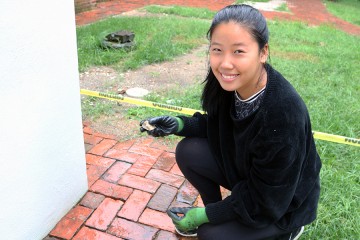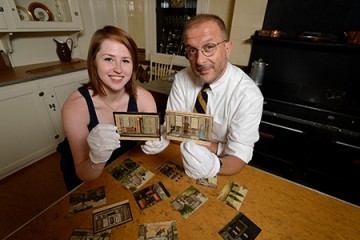I tracked down Elizabeth Schaaf in retirement to pester her about some moonshine. Schaaf was Peabody Institute's archivist from 1982 to 2008, and she was the one on site in the early aughts when construction workers pulled a stash out of the wall. But before I could get to the illicit liquor, Schaaf launched into another story: "You know, the Archives was actually started by a find."
It was the early 1980s, and she was working in the director's office when "an art historian came in and asked about a life-size photograph of George Peabody," she says. She told him he must be mistaken. Sure, the institute had a portrait of Peabody, but it was an oil painting, not a photograph. She brought him to the room where it was hanging. "He said, 'Well that's it, that's the photograph.' And it turned out it was a life-size photograph of George Peabody that had been taken in London and then overpainted to look like an oil painting."
Schaaf, curious to learn more about the piece by artist John Jabez Edwin Mayall, headed to the Peabody Library to ask to see the painting's documentation in the archives. The librarian told her Peabody didn't have archives. Turns out, every time Schaaf—or anyone else—sent something to the archives, the library staff, knowing that such a thing did not exist, would just put it in storage. The elevator operator at the time, Elizabeth Bradley, mentioned that there was a storage room on the fourth floor that Schaaf might want to take a look at.
Inside was a floor-to-ceiling trove of letters, photographs, paintings, and records. "It was like the early history of Peabody was sitting there on these shelves and nobody knew about it but Mrs. Bradley." Schaaf took a stack of papers at random, just to see what might be there, and to her amazement found herself looking at just the information she sought. The painting—in desperate need of a cleaning and repair, having been torn when it fell off the wall onto a mimeograph machine—was sent to a restorer. And Schaaf, exhilarated by the find, applied to the National Historical Publications and Records Commission for a grant to start the Peabody Archives. With support from Robert Pierce, Peabody's director at the time, the Archives was founded in 1982. "I searched the place from top to bottom, from the rooms where the old furnaces used to be to the garret," she says. "Things just fell out of the walls, practically. It was like a treasure hunt. It was just amazing."
"And," she adds nonchalantly, "of course I ended up marrying that art historian," she says of husband Larry Schaaf. She goes on to tell me about many of the relics she uncovered during her career-long expedition. As it happens, bits of Hopkins history have been tucked away throughout all the university's buildings, only to turn up when someone tears down a wall or moves a bookcase. I decided to go on a treasure hunt of my own to learn about a few of these remnants of Hopkins' past. Read on for more, including that tale of sequestered spirits.
The eyes have it

Jackie O'Regan was surveying tidy rows of old stools, labware, and microscopes headed for recycling when her eyes met another's. The Johns Hopkins curator of cultural properties was in Macaulay Hall on the Homewood campus a couple of years ago to determine whether anything left in some soon-to-be-renovated laboratories was worth saving. Tucked among the detritus was a 1960s-era model of a pair of eyes: two painted wooden orbs dotted with large, black pupils that move up and down and from side to side when anyone pulls its weighted wires. The paint is worn from friction, a sign the object had gotten much use by students throughout the years. "It was this weird and really cool-looking thing, and I didn't want it to be forgotten," she says. Though she has little storage space on the collection shelves in her office—her purview usually includes objects that are not in museums, like outdoor sculptures or paintings hung throughout Johns Hopkins' campuses—O'Regan tucked the model among her hodgepodge of art and scientific artifacts. In spring 2018, she plans to lend it to students for the course Conservation of Material Culture: Art, Artifacts and Heritage Sites; she hopes they will be able to track down more information about the piece's history and significance.
A tip of his cap
In 2015, a workman repairing a hand-cranked cargo elevator in Evergreen's Carriage House reached into a dark corner of a support beam and pulled out a chauffer's cap. He was almost apologetic when he brought the artifact to James Archer Abbott, director and curator of Evergreen Museum & Library. "He said, 'Well, you know it's not exhibitable, and it's kind of ratty.'" But Abbott's mind went to a different place when he saw the cap, which is thought to have belonged to the last chauffer to serve Alice Warder Garrett, Evergreen's last resident, until her death in 1952.
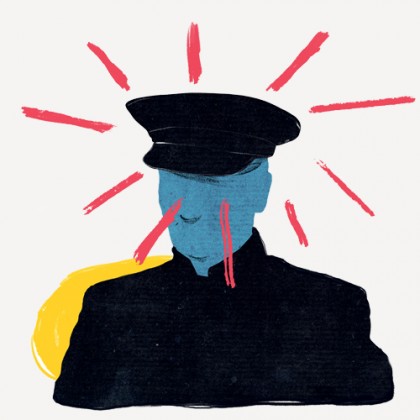
"The first thing I thought about was Mrs. Garrett burning letters, strangely enough," he says. You see, while Garrett left Johns Hopkins the house, the art, the china, and many boxes of records and correspondence, she destroyed the letters she considered most private and personal. "The sad thing about that is it makes for a cleaner, more purified, colder legacy. And that's where objects like this cap come in. She had such control over what would be acknowledged, what would be remembered. And then I thought about this chauffer. He had control over his contribution to the property too, and his control was in taking his hat off on that last day and tucking it away for a future generation to find." Abbott plans to display the cap in Evergreen's kitchen, where the chauffer would have had a cup of coffee, perhaps the only place in the house he would have been allowed.
Spin 'em right round
Henry Brem, director of the Department of Neurosurgery, was at a dedication ceremony for the Walter E. Dandy Professorship in Neurosurgery several years ago when one of Dandy's grandchildren went up to him with a question: Was Dandy actually that big of a deal? "And I said, it would be like going to a lawyer's convention or a congressional convention and talking about George Washington or Abraham Lincoln. I really think that's the analogy."
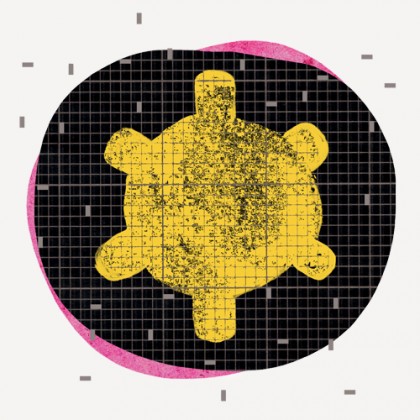
Years later, Brem and his colleagues were looking for space for the new Carnegie Center for Surgical Innovation, a research collaboration between Biomedical Engineering and Neurosurgery. Brem said they realized perhaps the most inspiring space (and one that happened to be sitting unused) would be a set of old operating rooms in the Carnegie Building where surgeons like Dandy pioneered techniques that pushed the field forward. As Brem and his colleagues walked through the space, they saw that on the floor, beneath carts of stored construction equipment, was a reminder of the distinction of those rooms: a six-pointed yellow compass. Dandy's Compass was used by the neurosurgeon to orient patients for his pneumoencephalography X-ray procedure, the precursor of the CT scan that first allowed doctors to see the location of brain tumors. The procedure used air injected into the brain or spinal cord as a contrast medium; doctors would use the compass to orient the patient's head in different directions, moving the air around to get a better visual. The construction workers "asked if we wanted to paint over it, and we said, 'Don't touch it,'" says Brem. Today, biomedical engineers and clinicians work on robots and new imaging techniques beside a reminder that Johns Hopkins has a long history of innovation. "You can't walk through there and think this is just a normal floor, or this is just a building," says Brem. "I can't think of a more inspirational place to be if I was an engineer or a graduate student."
Underground supper club
Because the Homewood Museum is on the National Register of Historic Places, whenever it undergoes renovations, an archaeologist must be on site. Staff decided to allow students to participate, conducting archaeological digs during renovations in 1977, 1983, and again this past summer. Just a few feet below ground, they found a dinner party, complete with mutton and pork (bones), oysters (shells), opulent china (broken bits), and—like any good dinner party—plenty of booze (OK, fragments of the bottles that once held wine, champagne, beer, and spirits). Historians believe many of these pieces were strewn around the foundation of the house to form "soak-away trenches" to help with drainage. The artifacts may not be quite as pristine as the porcelain and sterling silver that top the rest of the dining room once used by the Homewood estate's residents, "but those shards that were found—those really were used to serve the Carroll family," says museum Director and Curator Julie Rose. "And they really were washed by William Ross and plated by Sam, who were the butlers, or stored by Cis, who was a handmaid. These were pieces really touched by the lives of people, free and enslaved, who lived here."
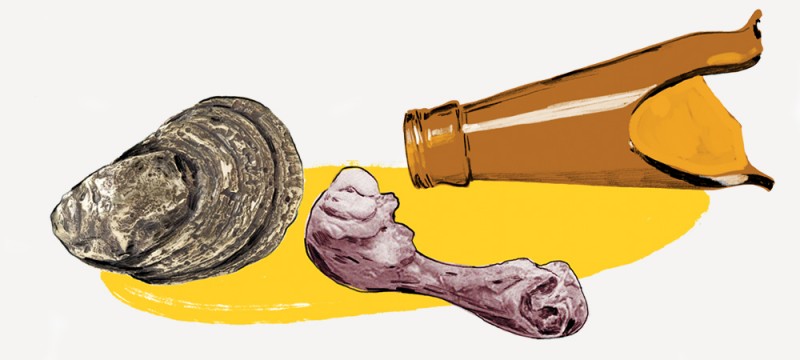
Safecrackers
When word first started to spread in the '80s that a walk-in safe had been found behind a bookcase in Gilman Hall, some speculated it might hold a mummified Egyptian cat missing from the Johns Hopkins archaeological collection. Steven Muller, then president of the university, announced a contest to challenge students to attempt to open the safe—no dynamite allowed. "They were using stethoscopes, turning dials, all the things you see in the old movies," says Jim Stimpert, senior reference archivist in Special Collections of the Sheridan Libraries. After no student could complete the task, a locksmith was brought in to drill it open. "They pried the hinges, which were not exactly well-oiled after all those decades, got the door open, went in, and found there wasn't a whole lot in there," Stimpert says with a laugh. "Which is sort of the way these things always seem to go. No gold bars stacked on the floor. The safe had been forgotten because there was nothing much of value in there." Among the items retrieved were a 78-rpm recording of train sound effects, a 1943 calendar, and empty chemical bottles. But one item of possible value was a box with 277 letters and documents relating to the Confederate Navy. Originally part of a collection donated by Baltimore-born historian and Confederate soldier J. Thomas Scharf, this particular box had gotten separated from the rest. Though some of the correspondence discusses plans of attack—including a plan for the crew of the Virginia to board and capture the Monitor by covering the smokestack and dropping flaming bottles of turpentine below deck, thus forcing the ironclad's crew out—many appear to be simple, mundane requests for supplies. It provides "an overview of how day-to-day operations went in the Confederate Navy in 1862," Stimpert says. "And that wasn't always letters describing great naval engagements. It was 'Hey, I need a barrel of flour,' and 'Sorry, we don't have any.' It gives you a sense of the conditions." And it's this seemingly ordinary back-and-forth that all too often isn't deemed important enough to include in historical collections, Stimpert says. So, in its own way, doesn't that make it valuable?
A hairy situation
We had just wrapped up our conversation about the naval papers when Stimpert ducked out and returned with a box. "I have no idea if this will be of any interest to you at all," he said, opening up the most recent file in a collection of items found in Milton S. Eisenhower Library books. The story he told me is a familiar one to most library patrons: After a long reading session, you decide to call it quits. You look around, grab the nearest flat item—a receipt, perhaps, or a piece of junk mail—and stick it in to mark your spot. When you return the book, you forget to give it a good shake, and somewhere between the circulation desk and the shelving cart the scrap is found and, at least at MSEL, it's preserved. Stimpert pulls out an article on paper marbling, a photocopied section of a Hebrew textbook, and a piece of mail sent from Germany in 1973. "Way back when, we decided that rather than try to decide that this might be of interest but this maybe not so much, we said let's just keep it all." They do draw the line, he says, at leaves, which rot, and human hair, which attracts vermin.
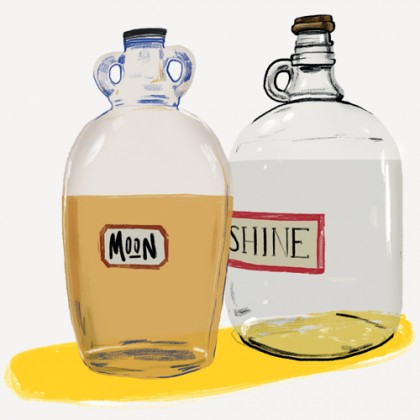
Back to the moonshine
Elizabeth Schaaf, in her decades-long hunt for hidden treasure, had stopped by a construction site in the institute's East Hall where workers were tearing out false walls as part of a renovation in 2003. "I said, if you find anything that looks old or interesting, give me a call and I'll come right down," she told them. "And I got any number of calls. In one, they said, 'Oh, I've got these bottles down here. Want me to pitch them?' And I went down and looked at the handwriting and I knew exactly who it was from." The eight glass jugs sported the handwriting of Gustav Strube, the founding conductor of the Baltimore Symphony Orchestra who had served on the Peabody faculty from 1916 to 1946. Strube was a close friend of journalist H.L. Mencken, who founded the Saturday Night Club, a collection of musicians who met weekly to drink and play music. When Prohibition hit, Strube, Mencken, and others took to making their own spirits to bring to the gatherings. Schaaf believes these particular bottles, made after Prohibition, were not left by accident. Strube had a long record of making wine or spirits and hiding bottles as presents in his friends' homes. Perhaps these bottles were a retirement gift left in a hiding spot that was just a little too good. The dusty bottles, filled with cloudy liquid, remain part of the Peabody Archives. When Peabody's current archivist, Matt Testa, is asked whether he's ever tempted to break open one of the bottles, he says no. "I wouldn't dare unleash what ghosts might be lurking inside."
Posted in Arts+Culture, University News
Tagged sheridan libraries, evergreen museum, archives, johns hopkins history





